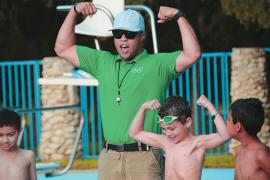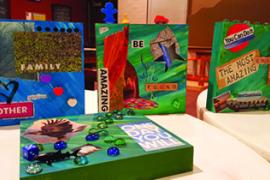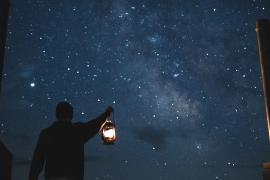My oldest child, Jane, once said she wished camp could be all year. Naturally, I asked her why, and she said, “We get to do everything at camp — when we hike in the woods, the camp staff tells stories about the plants and trees. It makes it easier to remember them. My camp friends care about me. They want me to make it to the top of the climbing tower. I’m not afraid to do things at camp that I am at school. Camp is happy. I love my camp friends. Grades, clothes, and money do not matter at camp. We see each other for who we really are.”
Powerful words for a nine-year-old (28 years ago).
At the time, I was an elementary school art teacher and program director for a private, independent girls’ camp. I had been going away to summer camp since I was nine years old. It was part of my DNA. I also loved teaching. Children were the center of my world. I wanted to do anything to make learning creative and exciting for them. Those powerful words from my own child completely changed the way I taught school the following year. I knew that somehow I needed to expand the reach of camp in my classroom. Furthermore, I knew that camps needed to expand their reach through schools.
School programs have existed for years in summer camps, national and state parks, and various outdoor agencies. Green River Preserve (GRP), our family’s summer camp, began partnering with schools in 1990. Each program we began led to another: residential, day, environmental science, sustainable agriculture, community outreach, and college credit. We have learned a lot and keep learning each year. I’m a true believer in sharing knowledge and learning from those who went before us.
Define Your Program and Develop a Strategic Plan
Our summer camp was established to connect children with nature and to share the joy of learning outside with them. It was a natural course for us to continue our summer camp environmental science program through school partnerships. While many camps have no specific educational component, we knew from the start that our school partnerships would be curriculum based. Hopefully, these tips will be helpful in your planning.
School partnership programs tend to fall into three categories:
- Educational: Programs are based on an interdisciplinary curriculum designed to meet state standards. Experientially based, camp education programs use environmental education and adventure learning to foster a connection with nature and to encourage environmental stewardship. Great examples of curriculum-based educational programs meeting standards are Project Wet and Project Wild (see resources list). Many camps use these curriculums rather than writing their own.
- Leadership: Programs are experientially based activities for developing skills and knowledge necessary to lead community and civic activities. Many youth leadership programs combine learning objectives with community service. The idea of service-learning provides youth with a focus on mastery of certain competencies for effective leadership. The core of most youth leadership programs includes vision, goals, responsibility, and teamwork. Trail maintenance for state and national forests near camps provides service-learning opportunities for leadership programs. Habitat for Humanity often partners with leadership programs for skills development.
- Adventure-based: Programs are experientially based learning challenges in an outdoor environment. These programs utilize adventure to facilitate growth for both individuals and groups. In 2002, the US Department of Education introduced The Partnership for 21st Century Skills. Many camps use the essential skills list of this partnership in their adventure-based partnership programs. The essentials of this list are called the “4 Cs” and include critical thinking and problem-solving, communication, collaboration, and creativity. Some examples of adventure-based programs partnering with schools are Outward Bound, NOLS, Adventure Treks, and Inside Out.
All school partnership programs have the capability of incorporating leadership and adventure-based activities into them. Most educational, curriculum-based camp programs:
- Are created on an interdisciplinary curriculum designed to meet state standards. This is not as intimidating as it sounds. All state standards are available online and easy to download. Use them as an outline for developing a curriculum. Having a certified teacher experienced in curriculum development as part of your planning team is always an asset. Their experience helps make the road to success run smoothly.
- Promote a strong collaboration with teachers, schools, and parents. Our programs include visits to the schools participating in our programs. This is a win-win for all, whether it is to teach a lesson, a Q & A session about their trip, or to attend an assembly based on their trip.
- Target a particular age range to meet the standards for certain grades in school. Adventure and leadership-based programs are flexible in planning custom trips for various ages.
Cultivate Your Program
All school partnership programs — residential or day — are a shoulder season to the regular camp season. How do you determine program length? Curriculum-based programs may require a certain number of days to cover the course of study. Leadership or adventure-based programs may be tailored to the schools’ needs.
Residential programs require an operating facility much like a summer camp season. For reference, our shoulder season staff is about one-third of our summer staff size. There are no cabin counselors to hire. Teachers and parents serve as chaperons in the cabins. Counselor duties, such as discipline and dealing with homesickness, are handled by the school. It greatly reduces staffing payroll. It frees up the camp directors to be involved with campers, staff, teachers, and parents. These are some of the reasons I love school programs.
Residential school programs cater to schools from all over. Day programs typically cater to local schools. And day programs are less expensive to run than residential programs. They do not have the staffing or facility needs of a residential program.
Research Is One of Your Best Allies to Success
Google has made research much easier than it was in 1990 when we began this journey. Our visit to the Teton Science School in 2004 was one of the most pivotal influences in developing our one school program further and to creating new ones. Whether online or in person, people love to share in our industry. It’s one of the things I adore about the camp world. In the course of your research, make sure to:
- Call, visit, and experience other school partnership programs (see resource list on page 66)
- Network with support organizations (see resource list on page 66). Attend their conferences and training workshops.
- Find out everything you can about grants — public, private, state, and local. Science, technology, reading, engineering, arts, and math (also known as STEM and/or STREAM) grants are available. They could be a school’s ticket to a funded school program.
- Collaborate with college professors and invite them to your programs. They are always looking for research opportunities for their students — and they often come with grants.
Explore Your Market Potential.
Private Schools
Private schools tend to have more funding for residential school programs and are eager to participate in them. Research private schools you know your campers attend and network with camp families in those schools.
State independent school associations are another good resource. These associations generally hold annual conferences, and you can submit a proposal to present at the conference or be an exhibitor.
Public Schools
Demographics and program will dictate public school participation. Magnet and charter schools have the best potential for participation. Teachers and parents involved in these schools generally strive to incorporate complementary educational programs. You can tap into that desire by presenting to education associations and faculty and at departmental meetings.
Colleges and Universities
Colleges and universities with environmental education programs often look to connect with local schools. This nature connection makes them ideal for partnership programs with camp too, and participants can often earn college credit for completing the program (see resources list on page 66 for more information).
Benefits
What are the benefits of residential school partnership programs to camps?
- They connect children with nature, the joy of learning outside — experiential learning.
- They are great marketing for summer camp.
- Residential field trip programs give young people an opportunity to experience camp with a safety net. Students leave wanting more and often return for summer camp.
- Parents and teachers experience camp firsthand and share their experience with knowledge. Often they become our most viral advocates for camp.
What are the benefits of day school partnership programs?
- They also connect children with nature and share the joy of learning outside — experiential learning.
- They introduce children to state and national parks within their own community.
- End-of-year test scores generally improve.
- They are a great vehicle for youth development and an investment in future leaders.
- They build community.
- Camp marketing is a built-in, positive side effect.
What are the drawbacks to school partnership programs?
- They require a big investment in time and energy in a second season.
- Financially, school programs are not huge money makers.
- Public schools have a harder time funding residential school programs.
- Transportation is expensive and often difficult for some schools.
Green River Preserve School Partnership Programs — Our Experience
In 2004, that same daughter, Anne, attended the Teton Science School (TSS) Graduate School program, in Jackson Hole, Wyoming. One look at their website (tetonscience
.org/graduate-program/home) and I was ready to go with her. Founded in 1960 by a local science teacher, Ted Major, TSS was everything I wanted to do with a camp and school partnership and more. Jack Shea, the director of the graduate school program, was winding down his 25-year career with TSS and I seized the opportunity to learn as much as I could from him.
The enthusiasm I felt for school partnerships with camps set off every creative spark in me. I wanted an opportunity for professional growth to exist in summer camps for teachers. If teachers were going to get on board with us, we needed to provide a way to encourage them. Place-based education and nature-based outdoor education were innovative teaching strategies. I realized right away that teachers could be our biggest advocates for camp. I wanted to reach out into our community so every school child could learn the camp way. Integrating place to engage students in authentic learning was my new goal. How was I going to accomplish this? I was a teacher at heart, and more than that, camp was in my DNA. I knew that learning the camp way was a critical component in child development. I had experienced it firsthand in my own classroom.
Wheels began to turn as I shared this information with my husband, Sandy, and our school partnership program at GRP took flight. Each one of the GRP programs is a different model for partnering with schools. All of them can be duplicated in your camp community. Here is a brief description of each one along with our personal experiences. We hope this will be helpful information in your journey to developing a school partnership.
School of Environmental Education (SEE)
SEE is the flagship environmental education program at GRP). Based on the GRP summer camp model of “Walking the Land,” SEE began in 1990 and currently operates for 14 weeks in the spring and fall.
What makes the GRP model unique and why would a school partner with GRP?
The educationally based, interdisciplinary curriculum is designed to both meet state standards and connect children with nature to share the joy of learning outside.
How does it extend into the school’s overall program?
Meeting educational standards fulfills a need for the school. Schools integrate the SEE program into a school term and realize significant end-of-year test score improvements.
Find SEE’s website at greenriverpreserve.org/school-programs/school-of-environmental-education.
Muddy Sneakers
The original idea behind Muddy Sneakers came to life after our first visit to the Teton Science School. Summer after summer we witnessed the invigorating effects of the outdoors on young people, as well as the importance of stories that define a sense of place, community, and relationship to the land. My husband, Sandy, felt that all children should have this experience, especially those right in our own backyard who had no idea they lived next to a state or national forest.
In 2007, fellow camp director, Chuck McGrady, Aileen Steinberg, and Sandy brainstormed the development of such a program on our front porch. It was the birth of Muddy Sneakers, a stand-alone 501C3 environmental science school outreach program. Based on the GRP camp model of “Walking the Land,” Muddy Sneakers provided an experiential format for teaching fifth grade science to participating public schools across Western North Carolina. Now serving 44 schools across seven counties for approximately 2,900 students, Muddy Sneakers has developed an extraordinarily cost-effective, results-driven model for learning by engaging children through the natural world.
You can find the Muddy Sneakers website at muddysneakers.org, and learn more from these Muddy Sneakers’ videos:
- muddysneakers.org/news-posts/muddy-sneakers-tedx-youtube-video
- muddysneakers.org/news.../nc-now-pbs-video-featuring-muddy-sneaker
Kids’ Agricultural Learning Experience (KALE)
KALE is a hands-on, agricultural-based learning program aligned with North Carolina state standards for education. Located on the Green River Preserve Farm, KALE invites youth in third and fourth grades to come get their hands dirty while learning about the world around them. Combined with an in-class lesson lead by GRP staff, KALE’s primary focus is to help youth from our local community make the connection between their food and how it fits into the many ecosystems. Participants leave feeling like they are part of their food cycle and understand ways that they can positively impact that cycle.
Like Muddy Sneakers, KALE connects children with nature in a hands-on learning environment. Studies show that experiential learning sparks creativity in students and increases their curiosity for learning. End-of-year test scores improve and students gain a deep respect for their cultural heritage and ecological surroundings.
You can learn more about KALE at greenriverpreserve.org/school-programs/outreach-environmental-education.
Tiny Camp
Tiny Camp is our future outreach program in environmental and experiential education. Based out of a tiny camper cabin on wheels, Tiny Camp is a “camp to go,” on-site program for connecting children with nature. Curriculum-based exhibits, lesson plans, games, camp activities, and GRP staff will travel to schools for this program.
Tiny Camp is designed to help meet the needs of the current No Child Left Inside Act of 2013. This act has been proposed to amend the Elementary and Secondary Education Act of 1965 regarding improving environmental literacy. Congress finds that: “Children and young adults are increasingly disconnected from the natural world around them, spending less time outside playing, exploring, and learning. Play and learning in nature is important to the intellectual, social, and physical development of youth.”
Queens University
GRP is very fortunate to partner with Queens University in Charlotte, North Caroline, for our high school expedition programs. Students/campers participating in GRP’s Western Expedition and Trailblazer’s Expedition may earn four college credit hours. Both of these programs are curriculum based and meet criteria established by Queens University.
What are the benefits for camps of partnering on programs with a university for college credit?
- Program enrichment
- Marketing incentive
- Research potential
- Grants
- Staffing opportunities for expeditions from university faculty
What are the benefits for the university?
- Freshman orientation and backpacking trip at GRP
- Faculty retreats
- Opportunities for teaching future teachers
The Perfect Vehicle
There will always be children out there who need camp but will never be able to attend. How can we as an industry help solve this problem?
As camp professionals, we are invested in youth development. Our camps are a perfect vehicle for partnering with schools in environmental literacy and/or outdoor adventure. While educators have been focused on defining the common core of required knowledge, learning at camp is about trying, making, doing, observing, contemplating, engaging, and getting involved. Camp provides a home base for real-life engagement. At the end of the day, we as an industry will have made an impact.
Photo courtesy of Wilderness Adventures, Jackson Hole, Wyoming; and URJ Crane Lake Camp, West Stockbridge, Massachusetts.
Missy Schenk is the executive director of Green River Preserve, a noncompetitive, coed summer camp connecting children with nature in the Blue Ridge Mountains of North Carolina.



